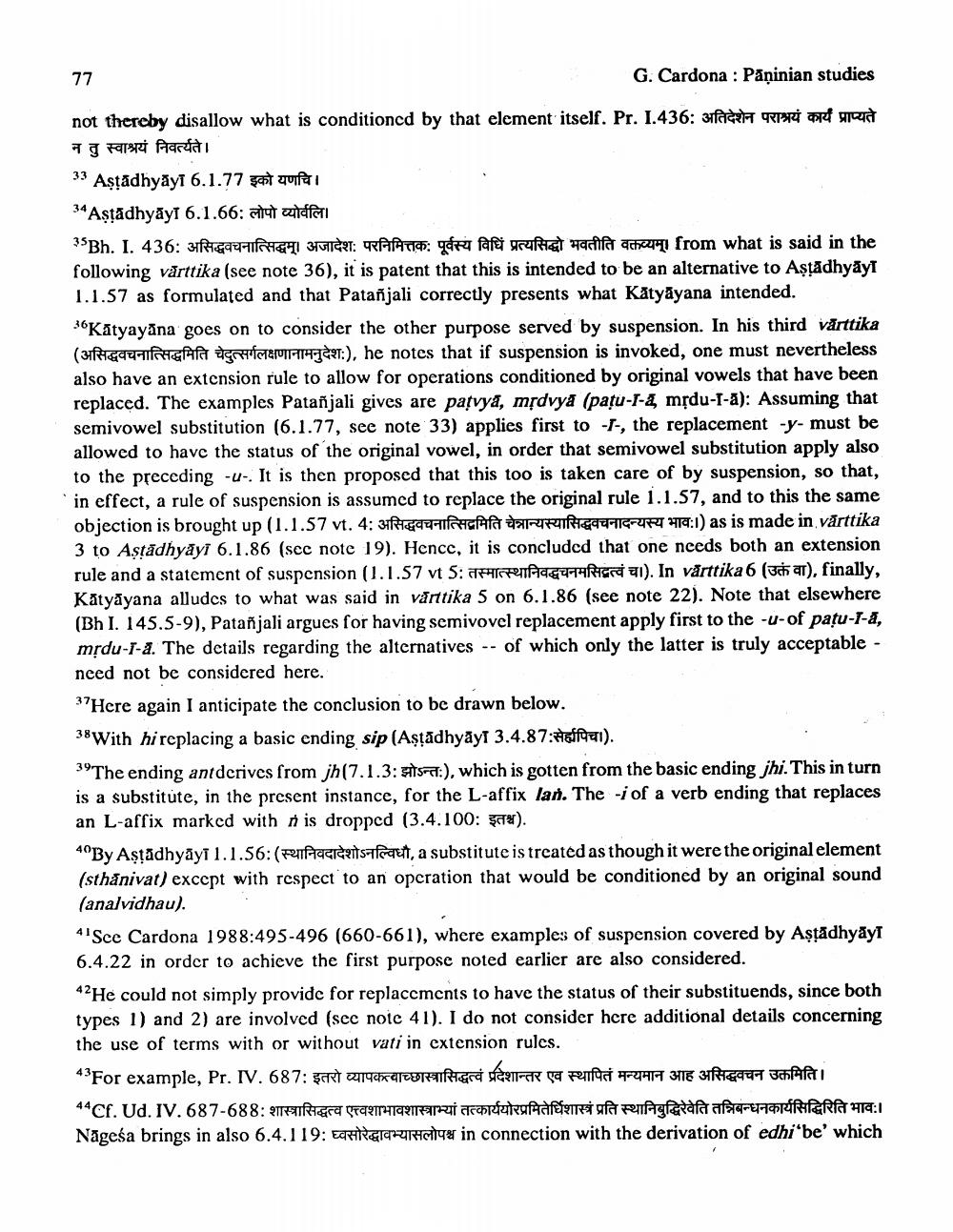________________
77
G. Cardona : Päninian studies
not thereby disallow what is conditioned by that element itself. Pr. I.436: 3 न तु स्वाश्रयं निवर्त्यते ।
33
Astādhyāyī 6.1.77 इको यणचि ।
Aṣṭadhyay 6.1.66:
35 Bh. 1. 436: असिद्धनात्सिद्धम् अजादेशः परनिमित्तकः पूर्वस्य विधिं प्रत्यसिद्धो भवतीति वक्तव्यम् from what is said in the following värttika (see note 36), it is patent that this is intended to be an alternative to Aṣādhyāy 1.1.57 as formulated and that Patanjali correctly presents what Katyayana intended.
Katyayana goes on to consider the other purpose served by suspension. In his third värttika (असिद्धवचनात्सिद्धमिति चेदुत्सर्गलक्षणानामनुदेश), he notes that if suspension is invoked, one must nevertheless also have an extension rule to allow for operations conditioned by original vowels that have been replaced. The examples Patanjali gives are patvya, mrdvya (patu-1-4, mrdu-I-a): Assuming that semivowel substitution (6.1.77, see note 33) applies first to F, the replacement -y must be allowed to have the status of the original vowel, in order that semivowel substitution apply also to the preceding -u. It is then proposed that this too is taken care of by suspension, so that, in effect, a rule of suspension is assumed to replace the original rule 1.1.57, and to this the same objection is brought up (1.1.57 vt. 4: fgfhin dezenfience) as is made in värttika 3 to Aṣṭādhyāyī 6.1.86 (see note 19). Hence, it is concluded that one needs both an extension rule and a statement of suspension (1.1.57 vt 5:1). In värttika 6 (3), finally, Katyayana alludes to what was said in varttika 5 on 6.1.86 (see note 22). Note that elsewhere (Bh I. 145.5-9), Patanjali argues for having semivovel replacement apply first to the -u-of patu-T-a, mrdu-1-4. The details regarding the alternatives of which only the latter is truly acceptable -
need not be considered here.
"Here again I anticipate the conclusion to be drawn below.
With hireplacing a basic ending sip (Aṣṭadhyay 3.4.87).
39The ending antderives from jh(7.1.3: ss), which is gotten from the basic ending jhi. This in turn is a substitute, in the present instance, for the L-affix lad. The iof a verb ending that replaces an L-affix marked with n is dropped (3.4.100:
).
40By Aṣṭadhyay 1.1.56: (neretsafe, a substitute is treated as though it were the original element (sthanivat) except with respect to an operation that would be conditioned by an original sound (analvidhau).
41Sce Cardona 1988:495-496 (660-661), where examples of suspension covered by Aşṭādhyāy 6.4.22 in order to achieve the first purpose noted earlier are also considered.
*He could not simply provide for replacements to have the status of their substituends, since both types 1) and 2) are involved (see note 41). I do not consider here additional details concerning the use of terms with or without vati in extension rules.
43For example, Pr. IV. 687 : इतरो व्यापकत्वाच्छास्त्रासिद्धत्वं प्रदेशान्तर एव स्थापितं मन्यमान आह असिद्धवचनमिति।
4Cf. Ud, IV. 687688 शास्त्रासिद्धत्व एत्वशाभावास्याभ्यां तत्कार्ययोरप्रमितेर्विशास्त्रं प्रति स्थानिबुद्धिरेवेति तन्निबन्धनवार्यसिद्धिरिति भावः । Nagesa brings in also 6.4.119: Et in connection with the derivation of edhi'be' which




